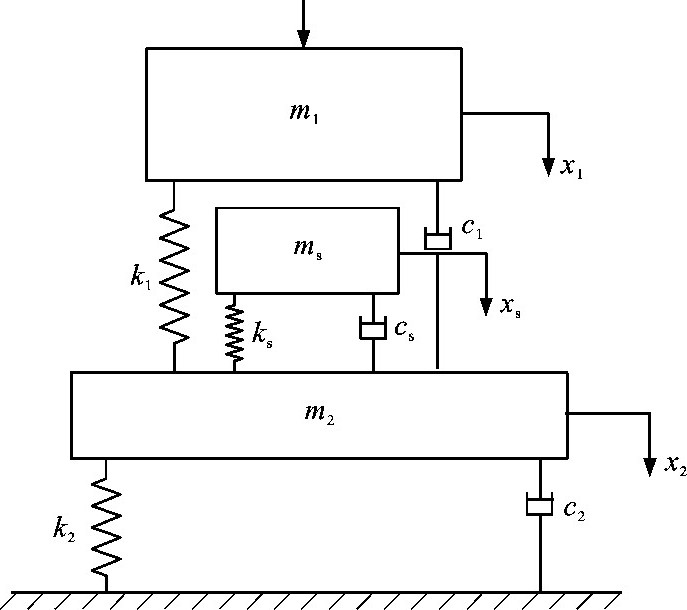Effect of subsystem parameters on vibration isolation characteristics of two-stage vibration isolation system
Article Text (Baidu Translation)
-
摘要: 为了阐明子系统参数对双层隔振系统隔振特性的影响, 建立了针对带子系统的双层隔振系统的三自由度动力学模型; 推导了一、二级主系统与子系统振幅比的解析式; 分析了3种振幅比随子系统质量比、固有频率比和阻尼比的变化规律; 给出了子系统充当双层隔振系统吸振器时最优参数的解析解和数值精确解; 以中国首批内燃动车动力包为研究对象, 探讨了散热器子系统的刚度、阻尼和质量对动力包双层隔振系统隔振性能以及柴油发电机组和散热器本身振动烈度的影响规律; 得到了最优散热器隔振器刚度的动力包双层隔振系统样机, 并进行了振动试验。试验结果表明: 散热器隔振器刚度大于拐点处刚度1.5倍会严重恶化子系统的振动情况, 其阻尼损耗系数取0.24左右能有效抑制双层隔振系统力传递率和振动烈度比的峰值, 取较大的散热器质量能有效提高双层隔振系统的隔振性能, 减小机组和散热器本身的振动烈度; 经过设计后, 停机工况下二级隔振器最大动反力减小50%, 常规工况下二级隔振器的实测最大动反力为296N, 优于同类水平, 常规工况下机组与散热器实测振动烈度最大值分别为15.45、4.97mm·s-1, 水平优秀。可见, 取较大的子系统质量和阻尼, 并将其视为双层隔振系统的吸振器进行优化设计, 可使双层隔振系统在柴油机启停机工况和常规工况下都具备较优的动力学性能。Abstract: To determine the effect of subsystem parameters on the vibration isolation characteristics of a two-stage vibration isolation system (TSVIS), a three degrees-of-freedom (3-DOF) dynamics model of TSVIS with a subsystem was established. The analytical expressions for the amplitude ratio of the first-and second-stage main system and the subsystem were derived. The variation rules of these three amplitude ratios with the mass, natural frequency, and damping ratio of the subsystem were analyzed. The exact analytical and numerical solutions of the optimum parameters for the subsystem as an absorber on TSVIS were presented. The first batch of diesel railcar power packs in China were selected as the research objects, and the influences ofstiffness, damping, and mass of the radiator on the vibration isolation performance of the power pack TSVIS and the vibration intensities of the diesel generator set and radiator were investigated. The prototype of the power pack TSVIS with the optimum stiffness of the radiator isolator was obtained. A vibration test was carried out. Test result shows that a radiator vibration isolator stiffness greater than 1.5 times the turning point stiffness can seriously deteriorate the radiator's vibrations. A damping loss factor of approximately 0.24 can effectively restrain the vibration intensity and force transmission ratio peak of the TSVIS. A larger mass of the radiator can effectively improve the vibration isolation performance of the TSVIS and reduce the vibration intensities of both the diesel unit and the radiator. The maximum dynamic reaction force, under the stalling condition of the second-stage vibration isolator, reduces by 50%. The maximum measured dynamic reaction force of the second-stage vibration isolator under normal condition is 296 N, which is better than the current value. The maximum measured vibration intensities of the diesel unit and radiator under normal condition are 15.45 and 4.97 mm·s-1, respectively, which represents an exceptionally satisfactory level. Therefore, by employing a larger mass and damping of the subsystem, and optimizing the TSVIS by regarding it as a vibration absorber, can improve the dynamic performances of the TSVIS under diesel engine starting, stalling and normal conditions.43 figs, 25 refs.
-
[1] CHEN X, QI H, ZHANG Y, et al. Optimal design of a twostage mounting isolation system by the maximum entropy approach[J]. Journal of Sound and Vibration, 2001, 243 (4): 591-599. doi: 10.1006/jsvi.2000.3230 [2] NIU Jun-chuan, SONG Kong-jie, LIM C W. On active vibration isolation of floating raft system[J]. Journal of Sound and Vibration, 2005, 285 (1/2): 391-406. [3] SUN Tao, HUANG Zhen-yu, CHEN Da-yue. Signal frequencybased semi-active fuzzy control for two-stage vibration isolation system[J]. Journal of Sound and Vibration, 2005, 280 (3-5): 965-981. doi: 10.1016/j.jsv.2003.12.048 [4] LIU Chun-rong, XU Dao-lin, JI Jian-fei. Theoretical design and experimental verification of a tunable floating vibration isolation system[J]. Journal of Sound and Vibration, 2012, 331 (21): 4691-4703. doi: 10.1016/j.jsv.2012.05.019 [5] LU Ze-qi, BRENNAN M J, YANG Tie-jun, et al. An investigation of a two-stage nonlinear vibration isolation system[J]. Journal of Sound and Vibration, 2013, 332 (6): 1456-1464. doi: 10.1016/j.jsv.2012.11.019 [6] LU Ze-qi, YANG Tie-jun, BRENNAN M J, et al. On the performance of a two-stage vibration isolation system which has geometrically nonlinear stiffness[J]. Journal of Vibration and Acoustics, 2014, 136 (6): 1-5. [7] WANG Xin-long, ZHOU Jia-xi, XU Dao-lin, et al. Force transmissibility of a two-stage vibration isolation system with quasi-zero stiffness[J]. Nonlinear Dynamics, 2017, 87 (1): 633-646. doi: 10.1007/s11071-016-3065-x [8] MA Xiang-long, JIN Guo-yong, LIU Zhi-gang. Active structural acoustic control of an elastic cylindrical shell coupled to a twostage vibration isolation system[J]. International Journal of Mechanical Sciences, 2014, 79 (1): 182-194. [9] FIEBIG W, WRÓBEL J. Two stage vibration isolation of vibratory shake-out conveyor[J]. Archives of Civil and Mechanical Engineering, 2017, 17 (2): 199-204. doi: 10.1016/j.acme.2016.10.001 [10] HUANG Wei, XU Jian, ZHU Da-yong, et al. Multi-objective optimization of composite two-stage vibration isolation system for sensitive equipment[J]. Journal of Engineering, Design and Technology, 2016, 14 (2): 343-361. doi: 10.1108/JEDT-12-2014-0074 [11] CHOI W J, XIONG Y P, SHENOI R A. Power flow analysis for a floating sandwich raft isolation system using a higher-order theory[J]. Journal of Sound and Vibration, 2009, 319 (1/2): 228-246. [12] FANG Yuan-yuan, ZUO Yan-yan, XIA Zhao-wang. Vibration transmission analysis of nonlinear floating raft isolation system with magneto-rheological damper[J]. Journal of Low Frequency Noise, Vibration and Active Control, 2018, 37 (1): 1-11. [13] SUN H L, ZHANG K, ZHANG P Q, et al. Application of dynamic vibration absorbers in floating raft system[J]. Applied Acoustics, 2010, 71 (3): 250-257. doi: 10.1016/j.apacoust.2009.09.005 [14] ZHAO Cun-sheng, ZHU Shi-jian, HE Qi-wei. Fuzzy-PID control method for two-stage vibration isolation system[J]. Journal of Theoretical and Applied Mechanics, 2007, 45 (1): 171-177. [15] SONG Chun-sheng, XIAO Yao, YU Chuan-chao, et al. H∞active control of frequency-varying disturbances in a main engine on the floating raft vibration isolation system[J]. Journal of Low Frequency Noise, Vibration and Active Control, 2017, 36 (1): 1-17. [16] LEI Xiao-fei, WU Cheng-jun, WU Heng-liang. A novel composite vibration control method using double-decked floating raft isolation system and particle damper[J]. Journal of Vibration and Control, 2017, 23 (10): 1-12. [17] HUI C K, NG C F. The effects of floating slab bending resonances on the vibration isolation of rail viaduct[J]. Applied Acoustics, 2009, 70 (6): 830-844. doi: 10.1016/j.apacoust.2008.09.018 [18] 牛军川, 李蒙, 郭浩男. 柔性基础上斜置隔振系统的功率流传递特性[J]. 内燃机学报, 2010, 28 (5): 470-474. https://www.cnki.com.cn/Article/CJFDTOTAL-NRJX201005015.htmNIU Jun-chuan, LI Meng, GUO Hao-nan. Power flow transmission in isolation systems with inclined mounts and flexible foundations[J]. Transactions of CSICE, 2010, 28 (5): 470-474. (in Chinese). https://www.cnki.com.cn/Article/CJFDTOTAL-NRJX201005015.htm [19] 张志, 张兆会, 董森, 等. 橡胶双层减振与隔振系统冲击响应研究[J]. 振动与冲击, 2013, 32 (23): 126-129. doi: 10.3969/j.issn.1000-3835.2013.23.023ZHANG Zhi, ZHANG Zhao-hui, DONG Sen, et al. Shock response of a rubber double-deck vibration isolation system[J]. Journal of Vibration and Shock, 2013, 32 (23): 126-129. (in Chinese). doi: 10.3969/j.issn.1000-3835.2013.23.023 [20] 孙玉华. 内燃动车动力包双层隔振设计方法研究[D]. 成都: 西南交通大学, 2013.SUN Yu-hua. Research on two-stage vibration isolation design method of powerpack in diesel railcar[D]. Chengdu: Southwest Jiaotong University, 2013. (in Chinese). [21] 孙玉华, 董大伟, 闫兵, 等. 双层隔振系统模态匹配分析及其振动特性[J]. 振动、测试与诊断, 2014, 34 (4): 727-731, 781. doi: 10.3969/j.issn.1004-6801.2014.04.022SUN Yu-hua, DONG Da-wei, YAN Bing, et al. Modal matching analysis and vibration characteristics of two-stage vibration isolation system[J]. Journal of Vibration, Measurement and Diagnosis, 2014, 34 (4): 727-731, 781. (in Chinese). doi: 10.3969/j.issn.1004-6801.2014.04.022 [22] 孙玉华, 董大伟, 闫兵, 等. 双层隔振系统解耦优化研究[J]. 振动、测试与诊断, 2014, 34 (2): 361-365, 402. doi: 10.3969/j.issn.1004-6801.2014.02.026SUN Yu-hua, DONG Da-wei, YAN Bing, et al. Design and decoupling optimization of two-stage vibration isolation system[J]. Journal of Vibration, Measurement and Diagnosis, 2014, 34 (2): 361-365, 402. (in Chinese). doi: 10.3969/j.issn.1004-6801.2014.02.026 [23] 孙玉华, 董大伟, 闫兵, 等. 柴油机双层隔振系统刚度优化及试验分析[J]. 内燃机学报, 2014, 32 (2): 186-191. https://www.cnki.com.cn/Article/CJFDTOTAL-NRJX201402014.htmSUN Yu-hua, DONG Da-wei, YAN Bing, et al. Stiffness optimization and experimental analysis on two-stage vibration isolation system of diesel engine[J]. Transactions of CSICE, 2014, 32 (2): 186-191. (in Chinese). https://www.cnki.com.cn/Article/CJFDTOTAL-NRJX201402014.htm [24] 陈俊, 闫兵, 董大伟, 等. 子系统参数对双层隔振系统固有特性的影响[J]. 振动与冲击, 2015, 34 (4): 110-116. https://www.cnki.com.cn/Article/CJFDTOTAL-ZDCJ201504019.htmCHEN Jun, YAN Bing, DONG Da-wei, et al. Effects of subsystem parameters on the natural characteristics of a double-layer vibration isolation system[J]. Journal of Vibration and Shock, 2015, 34 (4): 110-116. (in Chinese). https://www.cnki.com.cn/Article/CJFDTOTAL-ZDCJ201504019.htm [25] 陈俊, 董大伟, 时威振, 等. 带子系统的动力包双层隔振系统隔振设计研究[J]. 振动与冲击, 2016, 35 (16): 211-218. https://www.cnki.com.cn/Article/CJFDTOTAL-ZDCJ201616034.htmCHEN Jun, DONG Da-wei, SHI Wei-zhen, et al. Vibration isolation design for powerpack two-stage isolation system with a subsystem[J]. Journal of Vibration and Shock, 2016, 35 (16): 211-218. (in Chinese). https://www.cnki.com.cn/Article/CJFDTOTAL-ZDCJ201616034.htm -





 下载:
下载:












































